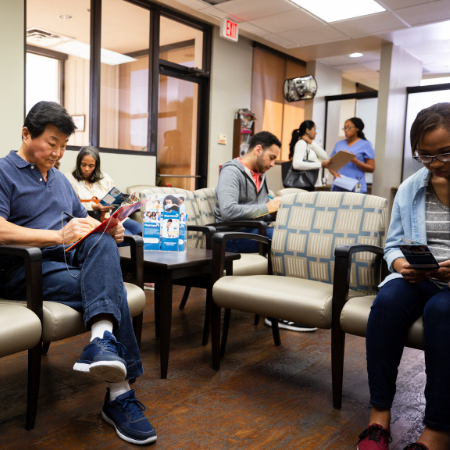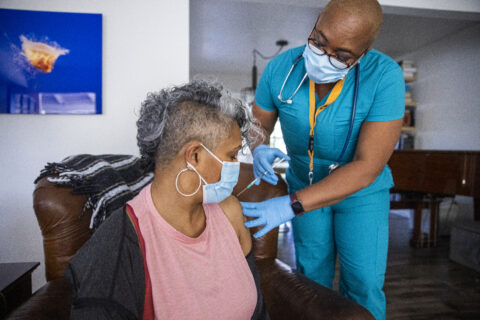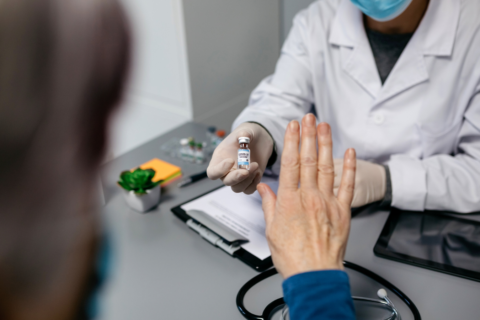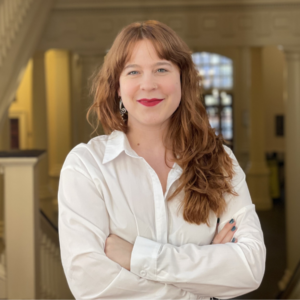Although the COVID-19 pandemic has affected us all, it has not affected us equally. The stark racial disparities of the pandemic are deeply concerning as Black and Hispanic Americans are three times as likely to be hospitalized and twice as likely to die from COVID-19 as White Americans. Early data indicates that a similar level of racial disparity exists with the vaccination rollout: Black and Hispanic people are receiving relatively fewer vaccines compared to their percentage of COVID-19 cases and their percentage of the overall population.
Two of the biggest factors that are exacerbating this reality is the lack of access to vaccine sites and a significant lack of trust among Black people in the vaccination process. The challenge of traveling to vaccination centers is particularly difficult for those without cars or access to public transit. This disproportionately impacts people of color, who are more than twice as likely to not own a car compared to White people. Conversely, nearly a quarter of Black people indicate that they regularly take public transportation, which is more than three times higher than for White people.
In addition to these barriers to vaccine access, a recent survey by the National Foundation for Infectious Diseases found that 47% of Black people were not confident in equitable distribution. This lack of trust is rooted in a history of unethical medical practices against Black people. It is thus incumbent on cities to intentionally strive to rebuild this trust by prioritizing equity in expanding access to vaccines.
Innovative Approaches

Cities across the country are already moving to address this systemic challenge by proactively addressing the lack of accessibility and working toward an equitable vaccine distribution strategy. These examples, and others, are captured in the COVID-19 Local Action Tracker, a partnership between the National League of Cities and Bloomberg Philanthropies launched last year to collect and share actions that cities are taking in response to COVID-19.
Data-Driven Vaccine Site Placement
In order to promote equitable vaccine distribution, it is critical to appropriately leverage data as part of the overall strategy. According to a COVID-19 Vaccine Toolkit produced by Bloomberg Philanthropies and the US Conference of Mayors, key pieces of data to measure include the percentage of population that has already been vaccinated disaggregated by race and the percentage of population within 20 minutes of a vaccination center disaggregated by race and transportation mode. These data points will enable cities to assess the current status of their vaccination efforts and develop strategic plans to improve equitable distribution moving forward.
Cities that are effectively leveraging data in this manner include Memphis, TN, which is utilizing data to prioritize the equitable placement of mass vaccination sites. City leaders worked to ensure that the population living within a mile of the four mass vaccination sites within city limits accurately mirrored the city’s racial demographics. Additionally, city leaders supported pop-up sites in neighborhoods that have low vaccination rates to ensure that all people had equitable access, irrespective of race or transportation mode. Other cities, such as Norfolk, VA, and San Francisco, CA, are using data from the U.S. Centers for Disease Control and the Census Bureau in partnership with neighborhood groups to pursue an equitable vaccine distribution strategy by decreasing barriers to access.
Free Transportation to Vaccine Sites
Cities are not only working to equitably identify vaccination sites, but they are also working to provide transportation to these sites so that mobility constraints do not prevent people from getting their vaccines. In Cincinnati, OH, the public transportation system is offering free rides on the dates of mass vaccinations events and providing shuttle service from the bus stop to the site entrance. In Austin, TX, CapMetro is leveraging its ADA paratransit service infrastructure to provide curb-to-curb free rides to vaccination sites that is available to everyone.
Other cities are pursuing public-private partnerships with ride-share companies to ensure that people without a car are still able to access vaccines. Los Angeles, CA, is partnering with Uber to provide 15,000 free rides, and another 20,000 at half off, to enable South L.A. residents to get to their appointments. City leaders in New Orleans, LA, together with local foundations and non-profits, are partnering with Uber to offer 20,000 rides to residents in order to ensure that a lack of transportation would not be a barrier preventing people from getting the vaccine. A partnership between Indiana University Health and Lyft provided free transportation rides to a mass vaccination event in Gary, IN.
Mobile Vaccine Units
Some cities are operationalizing mobile vaccination units to reach underserved communities directly. San Jose, CA, is engaging in a public-private partnership to purchase a mobile unit that will be used to reach communities disproportionately impacted by COVID-19. In Durham, NC, community groups have worked to repurpose old city buses and turn them into mobile vaccine units that are able to target communities that may otherwise struggle to reach mass vaccination sites. Additionally, Fort Worth, TX, is using a mobile vaccine clinic to reach residents without the ability to transport themselves to other centers and those who the city had used data to identify as being underserved.
Community Engagement
Another critical component of promoting equitable vaccine distribution is identifying trusted community partners who can help effectively communicate information among vaccine-hesitant communities. Chicago, IL, is engaging with faith-based organizations and social service agencies to share information and help schedule appointments within Black and Latinx communities. Detroit, MI, is building off its experience with Census outreach to send workers door-to-door in order to ensure that all people receive accurate information about the vaccine and how to schedule an appointment.
Recommendations
In order to recover from the health and economic impacts of the COVID-19 pandemic, widespread vaccine distribution is crucial. Amidst this process, it is essential that cities adopt an equity-centered lens in evaluating disparities in the vaccine distribution, especially among Black communities that have been disproportionately impacted by the pandemic. The examples highlighted in this blog reflect best practices that cities should not only consider adopting in the short-term as part of their vaccine distribution process, but also explore how these insights might inform long-term structural changes to their transportation infrastructure. Here are three points for city leaders to consider with regards to improving transportation equity in their communities:
- A key first step is utilizing data to evaluate transportation mode and usage disaggregated by race at both a citywide and neighborhood levels, where applicable. Correlating this data with the quality of the corresponding infrastructure will allow city leaders to better understand how different communities are able to travel around the city and access key services, including vaccines. This data-driven assessment may point to areas of transportation infrastructure investment that would promote greater equity. This could include extending the hours or increasing the frequency of transit service (Houston, TX), improving sidewalk quality (Seattle, WA) or installing raised crosswalks to promote the safety of all road users (Cincinnati, OH).
- Sometimes the best transportation infrastructure investments are not necessarily those that enhance people’s ability to travel (mobility), but rather those that decrease their need to travel (accessibility). As cities continue to pilot mobile vaccine centers, there are likely other types of city services that could build off this model by meeting residents directly where they are. This could include piloting mobile laundry trailers for those experiencing homelessness (Orlando, FL), launching a public library “Bookmobile” (Louisville, KY) or installing dynamic kiosks to improve wayfinding downtown (Mesa, AZ).
- Combining systemic data analysis with robust community engagement can help open up lines of communication and lead to further exploration of transportation equity issues. This is essential both with sharing important information, such as public health messaging around vaccines, and also eliciting critical community feedback to shape transportation infrastructure investment priorities. Efforts to promote such engagement could include providing financial support to faith-based groups who are assisting with vaccine distribution (Detroit, MI), launching online tools to elicit greater community feedback on city projects (Aurora, CO) or promote partnerships between city staff and community groups to ensure that those most impacted by transportation projects are able to share their input (Durham, NC).
A growing awareness of the systemic racial inequities within the vaccine distribution process and an intentional effort by many cities to address this challenge are important steps in the right direction. Improving the accessibility of cities’ transportation infrastructure is a powerful tool in promoting racial equity by ensuring that all residents are able to successfully access the services they need. Cities have the opportunity to leverage these best practices from vaccine distribution and use them to inform holistic change in their transportation systems.









